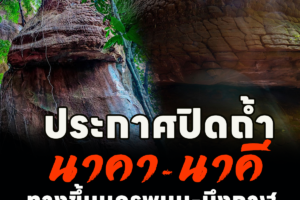
 LINE : ติดต่อผู้ดูแล
LINE : ติดต่อผู้ดูแล

“Despite relatively little promotion, we had more than 4,000 tourists visiting Tham Phra Waterfall during this year’s long holidays. When I went I was astonished to see a queue forming at the natural slide although I have to add that one visitor had an accident and was taken to hospital. It’s one of the most beautiful and interesting places in Bueng Kan and draws a large number of tourists. To get there you need to take a boat and because the waterway isn’t wide enough to accommodate many boats, we are looking for a forest path to the waterfall,” Rachata says.

“Another attractive tourist destination is Dongdipkala Phu Sing and the Dongsichomphu Forest Nature Room, especially Hin Sam Wan cliff, which is shaped like a whale. We held a cycling event here not that long ago and when the photos were uploaded to the social networks, we saw a significant increase in the number of visitors. Right now, I’m working on ensuring the area is both safe and clean as we are expecting many more tourists during the winter. Ideally, they should park at the bottom of the reserve then walk or cycle the trail through the forest. I know many people are attracted by the sheer beauty of Hin Sam Wan and are determined to climb it. But it is as dangerous as it is beautiful and we worry that tourists might fall into the chasm. In the distance, you can see Hin Rot Fai, which looks like a train consisting of five bogies and a smokestack.”
Last Sunday, Bueng Kan was home to the second edition of the cycling series, Tour of Isaan Classic, and hundreds of keen cyclists, from nearby provinces as well as Bangkok, turned out. The event was divided into two categories: a 100km road ride to Wat Phu Thok and a 50km mountain-bike ride to Phu Sing.
Wat Phu Thok, which is also known as Wat Chetiya Khiri Wihan, is not recommended for anyone who suffers from vertigo. You walk to the top via a wooden bridge that winds around the steep mountain. While the wooden bridge looked stronger than the last time I was here, when it was bouncing in the wind, it’s still a steep and nerve-wracking climb, probably because it symbolises the path of virtue that leads a righteous man to leave the world and enter the state of freedom through his own efforts.
Phu Thok is still a meditation practice centre as well as a centre and used for religious affairs by the local community. And the climb is well worth the effort: the view from the top is magnificent.
Visitors to the province can also take a boat trip on Bueng Khong Long, which was registered in 2001 one of the World’s Wetlands of International Importance and is the second largest wetland in Thailand. A massive fresh water reservoir initiated by His Majesty the King and the Royal Thai Irrigation Department with the aim of providing water for agriculture during the dry season, it is home to various rare plants and aquatic animals, such as the Mekong bumblebee goby as well as migrating birds like the plumed egret, tailed jacana and the lesser whistling duck.

Thai-Lao markets abound in town and are ideal places to pick up souvenirs. Our press group was taken to Ched Si and Phu Tham Phra waterfalls though access to the first was cut off due to heavy rainfall. Phu Tham Phra Waterfall, which flows down the 100-metre wide cliff to the valley, reminded us a little of the Niagara Falls, and is well worth a visit.
Dongdipkala Phu Sing and Dongsichomphu Forest Nature Room are home to several curiously shaped rocks, among them the elephant head-shaped Hin Hua Chang and the Kanpaeng Hin (Stone Wall), which feature a Buddha image.
Any trip to Bueng Kan should include a stop at Nong Gud Thing, a swamp with a rich biodiversity, including 20 fish species found nowhere else in the world.
We wrap our Bueng Kan trip by admiring 60 Chinese carved figures at Wat Weruwan and paying our respects to Luangphor Phra Sai at Wat Pho Chai.

‘>










